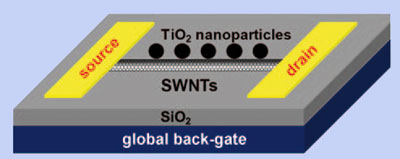Researchers from China and the US have combined titanium dioxide nanoparticles with carbon nanotubes to make light-sensitive transistors that can be made either to switch on or off in response to UV light. The work could be the basis for new types of sensors and optoelectronic devices, the scientists say.
Xuefeng Guo from Peking University, Beijing, teamed up with Dongsheng Xu, also at Peking University, and Colin Nuckolls of Columbia University, New York, combining the Xu group's expertise in making high-quality titanium dioxide nanoparticles with his own group's knowledge of carbon nanotube devices.
The transistors are made by mounting long single walled carbon nanotubes (SWNTs) between chromium and gold electrodes on a silicon wafer backing. They are then dipped in a solution containing the TiO2 nanoparticles, which have oleic acid groups on their surfaces to anchor them to the nanotubes.

The nanoparticle-coated nanotubes are light-responsive © Wiley-VCH |
When UV light shines on the nanoparticles, says Guo, free electrons gather on their surfaces, and can interfere with the current flow in the nanotubes. The team used a particular type of nanotubes which are ambipolar - they can conduct either electrons or positively charged 'holes' where electrons have been removed from the structure. Therefore, depending on which conduction mode is operating in the nanotube at the time, extra electrons will either enhance or block the current - giving the devices their ability to switch either way in response to UV light.
The combination of SWNTs and the TiO2 nanoparticles - both highly stable materials - allowed the group to make transistors that could be switched many times without degrading. 'For practical applications, reversibility is very important,' explains Guo. 'Up to now, the reversibility of this kind of switch hasn't been very good - after a few cycles the [light sensitive molecules] degraded. We wanted to use more stable stimulus-responsive components to improve the reversibility, which is why we chose inorganic titanium dioxide nanoparticles,' he adds.
'The fact that [the devices] can switch both ways is a very valuable observation,' comments Andrei Khlobystov, a specialist in carbon nanotube technologies from the University of Nottingham, UK.
'Nanotubes and nanoparticles are remarkable materials with interesting properties,' adds Khlobystov, 'so by making composite materials combining the two you have a good chance of retaining their intrinsic functional properties, but you can also come up with new properties. But the mechanisms of interactions between nanoparticles and nanotubes are not very well understood, and that's something this work is trying to address.' He adds that Guo's explanation of the switching effects sounds viable, but might be a little simplistic, given the intricacies of nanotube and nanoparticle behaviour - 'I wouldn't be surprised if there was something much more complex going on!'
Guo agrees that the interplay between the nanoparticles and nanotubes is crucial. 'The fact that carbon nanotubes can facilitate photoinduced charge separation in the nanoparticles implies that these hybrid materials might be good candidates for switching, sensing and photocatalysis applications,' he explains. He adds that elements that switch in opposite ways might also be combined into arrays or combined with functional molecular materials to make logic gates and related devices.
Phillip Broadwith


No comments:
Post a Comment